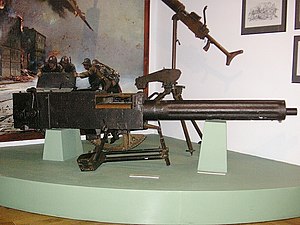| This article is missing information about higher-velocity Vickers class D firing 12.7x120mm SR . Please expand the article to include this information. Further details may exist on the talk page. (October 2021) |
| Vickers .50 machine gun | |
|---|---|
 A Vickers .50 machine gun, Polish Army Museum, Warsaw (2006) A Vickers .50 machine gun, Polish Army Museum, Warsaw (2006) | |
| Type | heavy machine gun Anti-aircraft gun |
| Place of origin | United Kingdom |
| Service history | |
| In service | 1933–1954 |
| Used by | United Kingdom Ireland |
| Wars | Second World War |
| Production history | |
| Manufacturer | Vickers, Enfield |
| Produced | 1933 - |
| Variants | Marks I–V |
| Specifications (Vickers .5 Mk V) | |
| Mass | 63 pounds (29 kg), excluding 10 pounds (4.5 kg) cooling water |
| Length | 52.4 in (1.33 m) |
| Barrel length | 31 in (0.79 m) |
| Cartridge | 12.7×81mm |
| Calibre | 0.5 inches (12.7 mm) |
| Rate of fire | 500–600 rounds per minute |
| Muzzle velocity | 2,540 feet per second (770 m/s) |
| Maximum firing range | Altitude: 9,500 feet (2,900 m) Range: 4,265 yards (3,900 m) |
| Feed system | belt |
The Vickers .5 inch machine gun (officially "Gun, Machine, Vickers, .5-in") also known as the Vickers .50 was a large-calibre British automatic weapon. The gun was commonly used as a close-in anti-aircraft weapon on Royal Navy and Allied ships, typically in a four-gun mounting (UK) or two-gun mounting (Dutch), as well as tanks and other armoured fighting vehicles. It was similar to the .303 in (7.7 mm) Vickers machine gun but fired the enlarged calibre British Vickers 0.5-inch (12.7 mm) ammunition; this round was shorter in length than the American .50 BMG (12.7×99mm).
Variants
Mark I and Mark II
The Mark I was the initial model but the gun went through further development before entering production and the first Mark to be taken into service was the Mark II. The Mark II entered service in 1933 and was mounted in some British light tanks, often paired with a 0.303 Vickers. The Mark II had a pistol grip rather than the spade grips of the infantry 0.303 machine gun.
Mark IV and V
Marks IV and V were improved versions and were also used on trucks in the North Africa Campaign such as by Long Range Desert Group It was superseded for use in British-built armoured fighting vehicles during the Second World War by the 15 mm (0.59 in) Besa machine gun, a Czech design adopted by the British for the Royal Armoured Corps.
The Mark IV was introduced in 1933 but not declared obsolete until 1944. It had full auto only at 600 rounds per minute.
The Mark V, introduced in 1935, was a strengthened variant and the main variant to be used. Fire rate was 500-600 rounds per minute.
Mark III

The Mark III was a naval version used as an anti-aircraft weapon, mostly by the Royal Navy and allied navies in the Second World War, typically in mountings of four guns but also as single and dual mounts. It proved insufficiently powerful at short-range against modern all-metal aircraft and was superseded during the Second World War by the Oerlikon 20 mm cannon. The naval quad mount featured a 200-round magazine per barrel, which wrapped the ammunition belt around the magazine drum. Maximum rate of fire of fire was 700 rounds per minute, per gun (cyclic) but could be reduced to 450. The four-barrel mounting had its guns adjusted to provide a spread of fire, amounting to 60 ft (18 m) wide and 50 ft (15 m) high at 1,000 yd (910 m). Vickers claimed that it could fire all 800 rounds in 20 seconds and could then be reloaded in a further 30 seconds. During the Second World War it was also mounted on power-operated turrets (usually a twin-gun mount) in smaller craft such as motor gunboats and motor torpedo boats.
See also
Notes
- Britain used Roman numerals to denote marks (versions) of ordnance until after the Second World War.
References
- Gun, Machine, Vickers .5-inch, Mk. II Vickers MG Collection & Research Association
- ^ Williams, The .5" Vickers Guns and Ammunition
- Gun, Machine, Vickers .5-inch, Mk. IV Vickers MG Collection & Research Association
- DiGiulian.
Bibliography
- The Vickers Machine Gun
- Tony DiGiulian, British 0.50"/62 (12.7 mm) Mark III
- Williams, Anthony G (November 2012). "The .5" Vickers Guns and Ammuntion". Archived from the original on 29 January 2022.
External links
| British Commonwealth naval weapons of the Second World War | |
|---|---|
| Monitor guns | |
| Capital ship main armament | |
| Heavy cruiser main armament | |
| Secondary armament and light cruiser main armament | |
| Minesweeper, Sloop, Corvette, Frigate and Destroyer armament | |
| Submarine guns | |
| Anti-aircraft weapons | |
| Light weapons | |
| Torpedoes | |
| Anti-submarine weapons |
|
| Small craft armament | |
| Foreign-sourced weapons | |
| Maxim gun derivatives | |
|---|---|
| Stationary machine guns | |
| Portable machine guns | |
| Heavy machine guns | |
This article relating to machine guns is a stub. You can help Misplaced Pages by expanding it. |